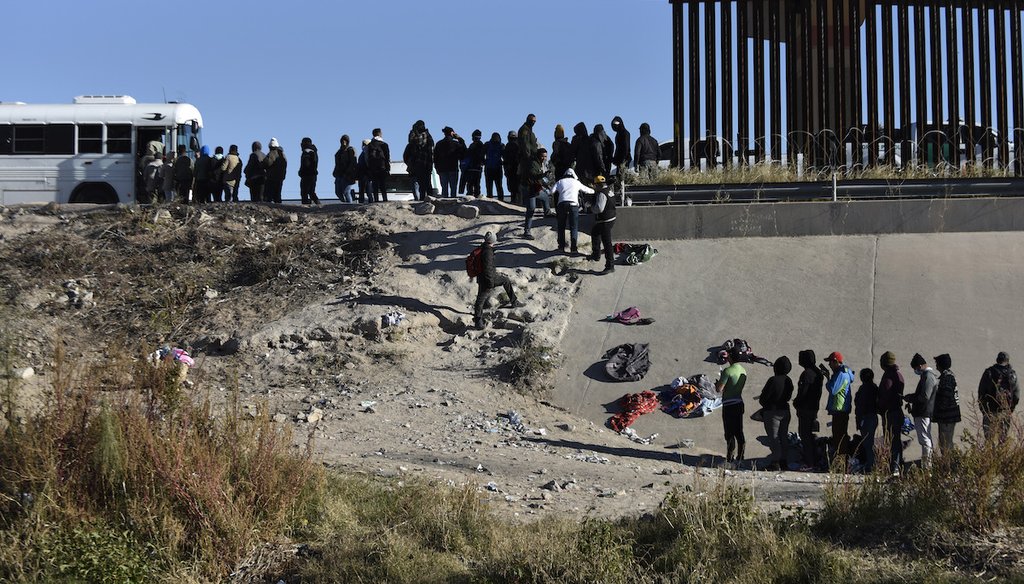Stand up for the facts!
Our only agenda is to publish the truth so you can be an informed participant in democracy.
We need your help.
I would like to contribute

Migrants wait to get into a U.S. government bus after crossing the border from Ciudad Juarez, Mexico, to El Paso, Dec. 12, 2022. (AP)
If Your Time is short
-
A public health policy that enables Border Patrol agents to immediately turn back immigrants at border crossings without allowing them to seek asylum could be rescinded as soon as Dec. 21. In-progress legal proceedings will determine the policy’s future.
-
Immigration numbers at the border have been rising for the past two years and are expected to continue increasing after Title 42 is lifted. The Department of Homeland Security plans to handle the expected uptick by hiring more immigration officials, creating additional processing centers and improving border surveillance technology.
-
If Title 42 is lifted, Border Patrol will return to using immigration law to determine whether immigrants at the border can enter the U.S.
Border towns around the United States are seeing an increase in immigrants trying to enter the country. Images have captured long lines with thousands of people crowding around fires to keep warm as they wait to enter.
And if Title 42, a public health policy that restricts immigration, is lifted, the number of people trying to enter the U.S. is likely to increase. A legal battle over Title 42’s future is playing out in the courts, but the policy could be rescinded as early as Dec. 21.
Here’s what we know about the possible end of Title 42 and what it could mean for immigration at the border.
Title 42 suspends legal consequences for multiple border crossing attempts
Title 42 is a section of federal law that gives the Centers for Disease Control and Prevention the authority to deny entry to the U.S. to people from countries where there is an outbreak of an infectious disease.
Former President Donald Trump’s administration enacted the public health policy in March 2020 in response to the COVID-19 pandemic. This authorized Border Patrol agents to immediately turn back immigrants at border crossings without allowing them to go through processing under immigration law and seek asylum.
Sign up for PolitiFact texts
Since March 2020, the Border Patrol has turned away immigrants around 2.4 million times, a little more than half the number of total encounters at the southern border, which is where the majority of the Title 42 expulsions take place.
Figures for encounters at the border represent the number of times Border Patrol agents stopped immigrants, not the number of individual immigrants stopped. That’s because the same immigrant can try more than once to cross the border, but each attempt is counted as an individual encounter.
That distinction became particularly important because under Title 42, immigrants do not face legal consequences for attempting to cross the border more than once — which is different from the rules under typical immigration law.
After Title 42 was imposed, the percentage of immigrants stopped more than once at the border increased from 7% in fiscal year 2019 to 27% in 2021.
Experts have said that Title 42 likely encouraged people to try to cross the border multiple times, but they have not predicted that attempts to cross will decrease if Title 42 is rescinded.
Border Patrol will still use immigration law, if Title 42 is lifted
If Title 42 is lifted, immigration at the border is expected to increase. Estimates of how many immigrants might try to enter the country each day are around 10,000. That’s compared with an average of around 9,000 daily encounters in October.
An uptick in immigration is already happening in certain border towns. In El Paso, Texas, Border Patrol encountered an average of 2,400 immigrants daily over the weekend of Dec. 10, compared with an average of around 1,800 a day in October.
Immigration at the border has been increasing for the past two years, even with Title 42 in place. That can be attributed to deteriorating conditions in other countries making people "so desperate, they're trying to come to the United States," Stephen Yale-Loehr, a Cornell University immigration law professor, told PolitiFact.
"People should not think that Title 42 somehow miraculously saves us from having to deal with immigration," he said. "We need to manage our immigration borders generally. And Title 42 is simply not the best way to do it."
If Title 42 is rescinded, Border Patrol officials will return to using immigration law to process people arriving at the border. Under those laws, immigrants stopped at the border go through formal processing. Immigration officials can deny entry to the U.S. under expedited removal policies; detain the immigrant; or release the immigrant into the U.S. while they await court proceedings.
With Title 42 in place, immigration law has been used for unaccompanied minors and immigrants from countries with strained diplomatic relations with the U.S., such as Venezuela.
Some politicians have claimed that Title 42 is the only tool Border Patrol has to control the flow of immigrants at the border, but we have rated that claim False. Physical barriers, surveillance technology, expedited removals and legal consequences for repeat border crossers are also at the Border Patrol’s disposal.
The Department of Homeland Security has updated its plan for the lifting of Title 42, saying it seeks to hire more Border Patrol agents, install additional surveillance technology and add Customs and Border Protection processing facilities.
Legal battles will determine Title 42’s continuation
The policy is at the center of several lawsuits that will determine its future:
-
In April 2022, the CDC tried to lift the policy, saying it was "no longer necessary" because of public health conditions at that time and increased availability of COVID-19 vaccines and therapeutics. But a group of largely Republican-led states sued the federal government, leading a Louisiana federal court to block the administration’s efforts to sunset the policy. The Justice Department said it would appeal the decision, but "it does not appear that the Department of Justice has filed an appeal," Susan Akram, professor at Boston University School of Law, told PolitiFact.
-
In a separate case, the American Civil Liberties Union sued the federal government over its use of Title 42. In November, a federal judge in Washington, D.C., ruled the administration must lift the policy. The judge granted the administration’s request for a period to prepare before the program sunsets; period will end Dec. 21.
-
On Dec. 7, the Biden administration announced its plan to appeal the D.C. federal court’s decision. The government is not planning to ask the court to reconsider whether the policy should be rescinded, but wants to ensure the policy can be used again if there is another public health emergency, said Yale-Loehr.
-
The group of Republican states that originally sued the federal government requested to intervene in the D.C. federal case, citing their ongoing lawsuit. They requested a decision by Dec. 16. If the court denies their intervention, the group requested a hold of seven days before Title 42 is rescinded so they can ask the U.S. Supreme Court to block the lifting of the policy while the case is decided.
These uncertainties mean Title 42 could end Dec. 21, when the period the Biden administration requested to prepare for ending the policy expires, or within a few months.
Our Sources
Phone interview, Stephen Yale-Loehr, Professor of Immigration Law Practice, Cornell Law School, Dec. 15, 2022
Email exchange, Susan Akram, Clinical Professor and Director of the International Human Rights Clinic, Boston University School of Law, Dec. 15, 2022
United States Code, 42 U.S.C., accessed Dec. 15, 2022
U.S. Customs and Border Protection, Southwest Land Border Encounters, accessed Dec. 15, 2022
U.S. Customs and Border Protection, CBP Enforcement Statistics Fiscal Year 2023, accessed Dec. 15, 2022
Centers for Disease Control and Prevention, CDC Public Health Determination and Termination of Title 42 Order, April 1, 2022
United States District Court Western District of Louisiana, Case 6:22-cv-00885, April 3, 2022
CNN, What is Title 42, and how does it connect to what’s happening now in El Paso?, Dec. 13, 2022
American Civil Liberties Union, Huisha-Huisha v. Mayorkas, Nov. 15, 2022
CNN, Federal judge blocks Title 42 rule that allowed expulsion of migrants at US-Mexico border, puts order on hold for 5 weeks, Nov. 16, 2022
United States District Court for the District of Columbia, Notice regarding decision to appeal the court’s November 15, 2022 Order and November 22, 2022 final judgment, Dec. 7, 2022
CNN, Legal fight over termination of Trump-era border policy intensifies as GOP-led states ask appeals court to rule by Friday, Dec. 13, 2022
Ellen Gilmer, tweet, Dec. 8, 2022
U.S. Customs and Border Protection, Nationwide Encounters, accessed Dec. 15, 2022
Texas Tribune, In El Paso, migrants are sleeping on the streets after thousands crossed the border last weekend, Dec. 14, 2022
Peter Jaquez, tweet, Dec. 12, 2022
PolitiFact, Title 42 is not ‘the last tool’ Border Patrol has to prevent illegal immigration, Aug. 31, 2022
U.S. Department of Homeland Security, Update on Southwest Border Security and Preparedness Ahead of CourtOrdered Lifting of Title 42, accessed Dec. 15, 2022
CNN, Biden administration releases plan for the scheduled lifting of Title 42 next week, Dec. 15, 2022




























